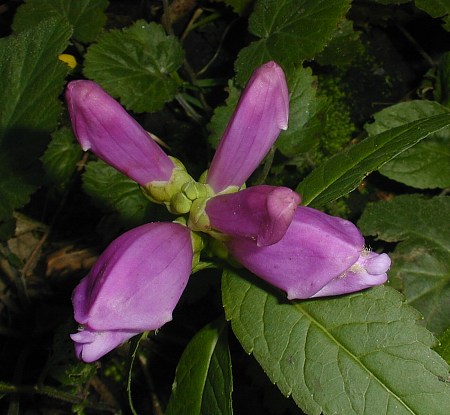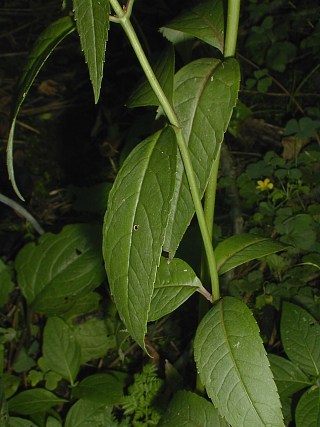Description: This herbaceous perennial plant is 1-3' tall and usually unbranched; it will form side branches if the central stem is broken. The central stem is light green, glabrous, and terete (round in cross-section); there are pairs of opposite leaves along its length that have a tendency to droop. The leaf blades are up to 6" long and 2¼" across; they are lanceolate to broadly lanceolate, hairless, and serrated along their margins. The upper surface of each leaf blade is medium to dark green, while its lower surface is pale green. At the base of each leaf blade, there is a short petiole about ¼–½" in length.

The central stem
terminates in a short spike of flowers. Each flower is 1–1½" in length;
it has a corolla with a flattened tubular shape and a short calyx with
5 blunt teeth. The two-lipped corolla is pink to deep rosy pink; the
upper lip has the shape of a broad hood, while the lower lip has 3
outer lobes. The central lobe of the lower lip is often elevated
slightly above the 2 lateral lobes when the flower is fully open.
Behind the lower lip of the corolla, there is a conspicuous patch of
white or pale yellow hairs. The calyx is light green and glabrous; it
has teeth that are broadly ovate or oval-ovate. Underneath the calyx of
each flower, there are short appressed bracts that resemble the teeth
of the calyx. The blooming period occurs from late summer to early fall
and lasts about a month. There is no floral scent. Ovoid seed capsules
develop after the corollas of the flowers turn brown and fall off. Each
seed capsule is about ½" long; it is initially light green and
glabrous, but later turns brown and splits open to release the seeds.
The root system is rhizomatous and vegetative colonies of plants
occasionally form.

Cultivation:
The preference is partial or dappled sunlight, consistently moist
conditions, and a fertile loamy soil with abundant organic matter. The
foliage is rarely disfigured by disease.
Range & Habitat:
The native Pink Turtlehead is an uncommon wildflower that is found
primarily in
southern and western Illinois; elsewhere in the state, it is rare or
absent (see Distribution
Map). Habitats include wet to moist floodplain forests,
swamps, soggy meadows and thickets, and partially shaded seeps and
springs. This species usually occurs in high quality habitats. It is
sometimes grown in flower gardens.
Faunal Associations:
The flowers are cross-pollinated primarily by bumblebees; sometimes the
Ruby-Throated Hummingbird also visits the flowers of Chelone
spp. (Turtleheads) for their nectar. The bitter foliage is
usually avoided by White-Tailed Deer and other mammalian herbivores.
Photographic Location:
A shaded wildflower garden in Urbana, Illinois.
Comments:
Pink Turtlehead is the only native Chelone sp.
(Turtlehead) in Illinois with pink to deep rosy pink flowers. It is an
attractive plant with turtlehead-shaped flowers. The other native
Turtlehead within the state is Chelone glabra
(White Turtlehead), which has white (or slightly pink) flowers and
shorter petioles (less than ¼"). Sometimes Chelone lyonii
(Lyon's Turtlehead) is grown in flower gardens, although it has not
naturalized within the state. This species is native to the Appalachian
mountains in the SE. Lyon's Turtlehead has flowers that are about the
same color as those of Pink Turtlehead, but it has wider leaf blades
and longer petioles (½–1½" long). Other common names that refer to Chelone
obliqua include Rose Turtlehead, Purple Turtlehead, and Red
Turtlehead. Plants that are offered for sale as 'Chelone obliqua' by
mass-market nurseries may be hybrids of undetermined parentage, rather
than the open-pollinated species.